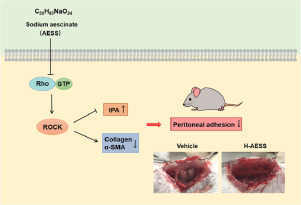当前位置:
X-MOL 学术
›
Phytomedicine
›
论文详情
Our official English website, www.x-mol.net, welcomes your
feedback! (Note: you will need to create a separate account there.)
Sodium aescinate significantly suppress postoperative peritoneal adhesion by inhibiting the RhoA/ROCK signaling pathway.
Phytomedicine ( IF 6.7 ) Pub Date : 2020-02-22 , DOI: 10.1016/j.phymed.2020.153193 Wenqin Liu 1 , Fei Qin 2 , Fuling Wu 3 , Haixing Feng 3 , Qin Yang 3 , Lianbing Hou 3 , Min Peng 3 , Benjie Zhou 4 , Lan Tang 5 , Chuqi Hou 5
Phytomedicine ( IF 6.7 ) Pub Date : 2020-02-22 , DOI: 10.1016/j.phymed.2020.153193 Wenqin Liu 1 , Fei Qin 2 , Fuling Wu 3 , Haixing Feng 3 , Qin Yang 3 , Lianbing Hou 3 , Min Peng 3 , Benjie Zhou 4 , Lan Tang 5 , Chuqi Hou 5
Affiliation

|
BACKGROUND
Although mechanical barriers and modern surgical techniques have been developed to prevent postoperative adhesion formation, high incidence of adhesions still represents an important challenge in abdominal surgery. So far, there has been no available therapeutic drug in clinical practice.
PURPOSE
In this study, we explored the efficacy of sodium aescinate (AESS) treatment against postoperative peritoneal adhesions, the potential molecular mechanism was also investigated.
STUDY DESIGN AND METHODS
Sixty male Sprague-Dawley rats were randomly divided into 6 groups for the study: the blank, vehicle, positive control and three AESS administration groups (0.5, 1 and 2 mg/kg/d, intravenous administration for 7 days). Adhesions were induced by discretely ligating peritoneal sidewall. An IL-1β-induced HMrSV5 cell model was also performed to explore possible functional mechanism.
RESULTS
The results indicated that the incidence and severity of peritoneal adhesions were significantly lower in the AESS-treated groups than that in the vehicle and positive control group. AESS-treated groups showed that the secretion, activity, and expression of tPA in rat peritoneum were notably increased. The FIB levels in rat plasma were decreased. The immunohistochemical staining analysis demonstrated that collagen I and α-SMA deposition were significantly attenuated in AESS-treated peritoneal tissues. Besides, we found that AESS treatment reduced the protein levels of p-MYPT1. To further explore the mechanisms of AESS, both activator and inhibitors of RhoA/ROCK pathway were employed in this study. It was found that AESS-induced up-regulation of tPA was reversed by activator of ROCK, but the effects of ROCK inhibitors were consistent with AESS.
CONCLUSION
Taken together, the findings of in vivo and in vitro experiments proved that AESS could significantly suppress postoperative peritoneal adhesion formation through inhibiting the RhoA/ROCK signaling pathway. Our researches provide important pharmacological basis for AESS development as a potential therapeutic agent on peritoneal adhesions.
中文翻译:

七叶皂苷钠通过抑制RhoA / ROCK信号通路显着抑制术后腹膜粘连。
背景技术尽管已经开发了机械屏障和现代手术技术来防止术后粘连形成,但是粘连的高发生率仍然代表腹部手术中的重要挑战。迄今为止,在临床实践中没有可用的治疗药物。目的在这项研究中,我们探讨了七叶皂苷钠(AESS)治疗术后腹膜粘连的疗效,并研究了潜在的分子机制。研究设计和方法60只雄性Sprague-Dawley大鼠随机分为6组:空白组,赋形剂,阳性对照组和3个AESS给药组(0.5、1和2 mg / kg / d,静脉内给药7天) 。通过不连续地结扎腹膜侧壁诱导粘附。还进行了IL-1β诱导的HMrSV5细胞模型以探索可能的功能机制。结果结果表明,AESS治疗组的腹膜粘连发生率和严重程度显着低于媒介物和阳性对照组。AESS处理组显示大鼠腹膜中tPA的分泌,活性和表达显着增加。大鼠血浆中的FIB水平降低。免疫组织化学染色分析表明,在经AESS处理的腹膜组织中,胶原蛋白I和α-SMA的沉积明显减弱。此外,我们发现AESS处理降低了p-MYPT1的蛋白质水平。为了进一步探讨AESS的机制,本研究使用了RhoA / ROCK途径的激活剂和抑制剂。已经发现,ROCK活化剂逆转了AESS诱导的tPA上调,但ROCK抑制剂的作用与AESS一致。结论总的来说,体内和体外实验的结果证明AESS可以通过抑制RhoA / ROCK信号通路显着抑制术后腹膜粘连的形成。我们的研究为AESS开发作为腹膜粘连的潜在治疗剂提供了重要的药理基础。
更新日期:2020-02-23
中文翻译:

七叶皂苷钠通过抑制RhoA / ROCK信号通路显着抑制术后腹膜粘连。
背景技术尽管已经开发了机械屏障和现代手术技术来防止术后粘连形成,但是粘连的高发生率仍然代表腹部手术中的重要挑战。迄今为止,在临床实践中没有可用的治疗药物。目的在这项研究中,我们探讨了七叶皂苷钠(AESS)治疗术后腹膜粘连的疗效,并研究了潜在的分子机制。研究设计和方法60只雄性Sprague-Dawley大鼠随机分为6组:空白组,赋形剂,阳性对照组和3个AESS给药组(0.5、1和2 mg / kg / d,静脉内给药7天) 。通过不连续地结扎腹膜侧壁诱导粘附。还进行了IL-1β诱导的HMrSV5细胞模型以探索可能的功能机制。结果结果表明,AESS治疗组的腹膜粘连发生率和严重程度显着低于媒介物和阳性对照组。AESS处理组显示大鼠腹膜中tPA的分泌,活性和表达显着增加。大鼠血浆中的FIB水平降低。免疫组织化学染色分析表明,在经AESS处理的腹膜组织中,胶原蛋白I和α-SMA的沉积明显减弱。此外,我们发现AESS处理降低了p-MYPT1的蛋白质水平。为了进一步探讨AESS的机制,本研究使用了RhoA / ROCK途径的激活剂和抑制剂。已经发现,ROCK活化剂逆转了AESS诱导的tPA上调,但ROCK抑制剂的作用与AESS一致。结论总的来说,体内和体外实验的结果证明AESS可以通过抑制RhoA / ROCK信号通路显着抑制术后腹膜粘连的形成。我们的研究为AESS开发作为腹膜粘连的潜在治疗剂提供了重要的药理基础。

































 京公网安备 11010802027423号
京公网安备 11010802027423号